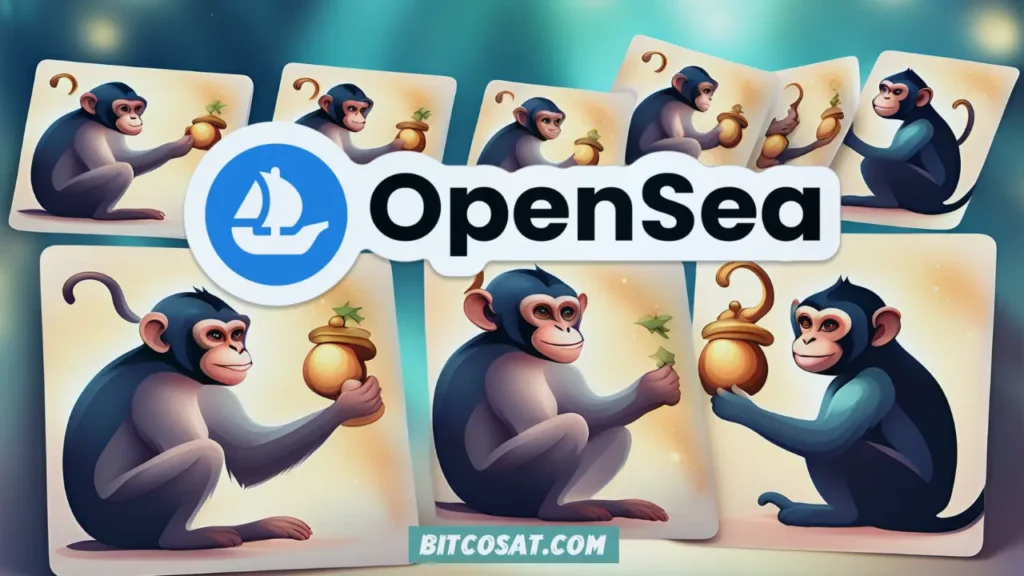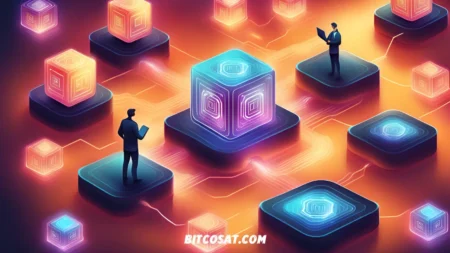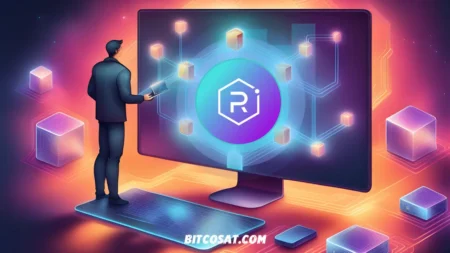Sales of the non-fungible token (NFT) industry rose in 2021, according to industry reports.
As sales volume boomed from $95 million to $25 billion in 2021, the OpenSea market is the leader of the largest NFT market in the world.
The OpenSea market was among the first markets to monitor the growth of the non-fungible token industry, in addition to its first position in that industry.
Since its inception in 2017, the OpenSea platform has witnessed a boom in NFT sales worth $20 billion, with the participation of more than a million merchants on this platform.
In this guide, we will monitor the pros and cons of the specialized OpenSea market to help the user better understand this market and how to benefit from NFT tokens, in addition to a future prediction for this platform in the crypto industry.
What is OpenSea Marketplace?
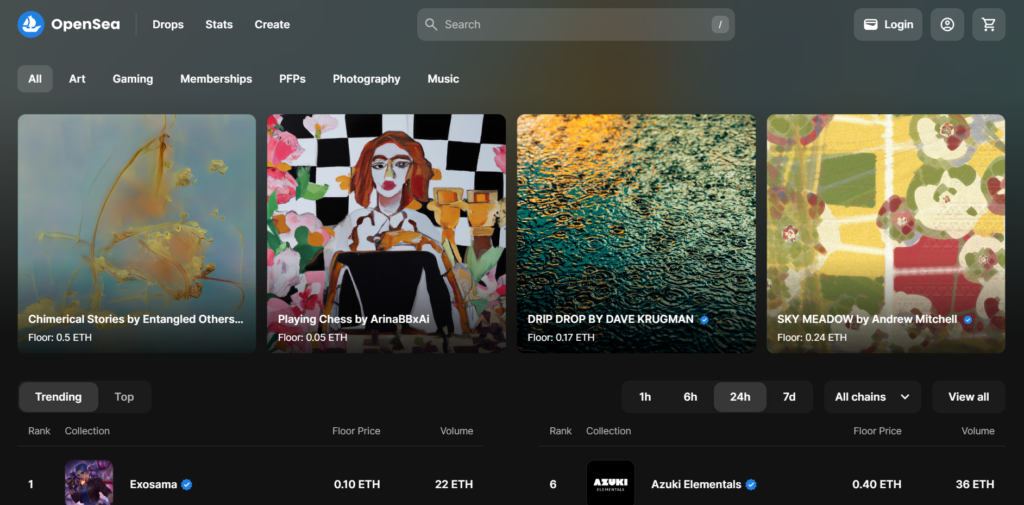
Entrepreneurial determination; Devin Finzer and Alex Atallah founded the OpenSea Marketplace in 2017 and are based in New York to research their work.
The project was a pioneer in the NFT industry, and the platform launched in 2021 in a trend that has not stopped.
Experience in technology helped the founders develop this business.
Finzer, who was born in the Bay Area and attended Brown University, went on to work as a software engineer at Pinterest and later co-founded the search engine Claimdog in 2015, which he then acquired by Credit Karma for an undisclosed sum shortly after its release.
As for Alex Atallah; He studied at Stanford University and worked at Zugata and Whatsgoodly in Silicon Valley after graduating.
The beginning of the OpenSea marketplace
Finzer and Atallah first collaborated in 2017 on the idea of a different startup that would pay users cryptocurrencies in exchange for their use of the company’s Wi-Fi hotspots.
At the same time, their idea coincided with the spread of the game CryptoKitties based on the Ethereum network.
It started as an NFT game, attracting the interest of many users, so the founders used their company to create a market for trading cryptocurrencies.
Their concept began to spread as the NFT industry boomed in 2021, making the OpenSea marketplace the largest platform specialized in this industry.
In continuation of its success, the company announced in 2022 that it had raised $300 million in investment capital.
The platform will be valued at $13.3 billion as a result of investing about $3 billion in NFT companies in 2021.
The OpenSea marketplace has become the leader in this trend for many companies and individuals.
How does Opensea work?
The OpenSea marketplace allows users to buy and sell digital assets with cryptocurrencies or fiat currencies.
It lists some of the most famous collections of non-fungible tokens that have achieved the largest sales in the NFT space through this market.
Non-fungible tokens indicate unique digital assets located on the blockchain network that cannot be exchanged for another asset, unlike Bitcoin, where 1 Bitcoin = another amount of one Bitcoin.
These tokens can also be traded and sold, which has attracted the majority of buyers specializing in digital art.
The platform uses smart contract technology to buy and sell unique tokens so that the owners of these tokens on the platform are insured while providing security to the creator.
The platform uses ERC721 and ERC1155 standards to verify that the collectors of these tokens own the images through which they are listed on the market.
The market is based on the Ethereum network, so for the user to buy or sell these tokens, he needs to have an Ethereum wallet, such as MetaMask, Coinbase, and TrustWallet, and connect the cryptocurrency wallet to the market.
What cryptocurrencies does Opensea Marketplace accept?
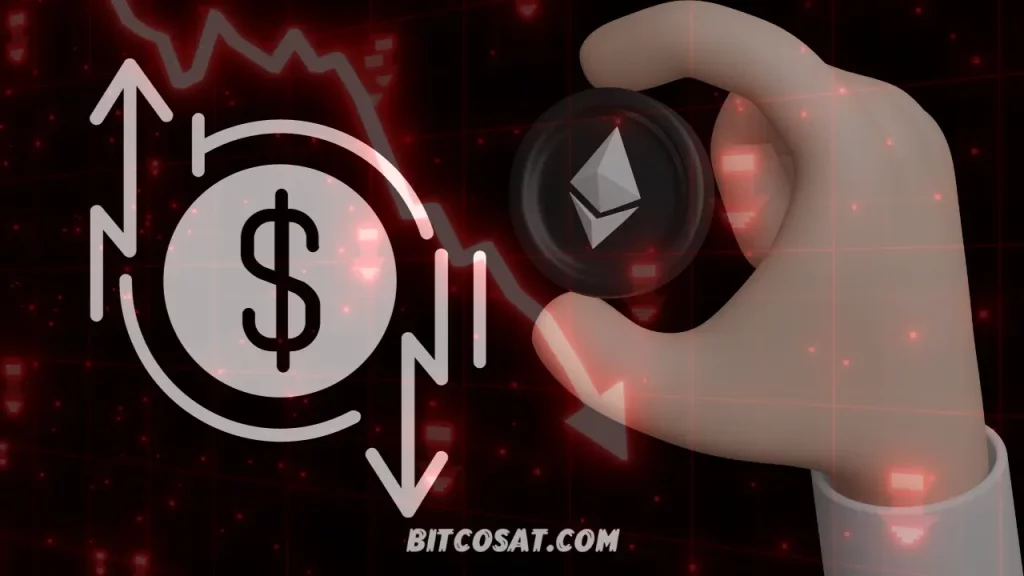
Platforms like the OpenC Market cater to both experienced and new crypto users.
The large sales witnessed in the NFT market attracted the interest of new people in the world of cryptocurrencies.
The problem of purchasing cryptocurrencies no longer represents as much suffering as in the past, as some platforms such as OpenSea have solved this problem.
The OpenSea marketplace supports more than 150 cryptocurrencies.
The main currencies used on the platform are Ethereum network currencies (ETH/WETH), USDC, and DAI.
The market also provides support via the Polygon and Ethereum networks.
For the user to participate in the platform’s auctions, he needs WETH currency.
Which refers to the hardcopy version of Ether and the ERC-20 token-compatible version of Ethereum.
The user just has to keep some Ether in the OpenSea wallet, which can then be transferred directly to WETH.
To start trading NFT on the OpenSea market, you need to have a crypto wallet and an account on a cryptocurrency exchange such as Coinbase or Binance.
The market provides users with the conversion of their cryptocurrencies into the local currency when they make transactions on the platform.
However, the market does not provide the use of paper currencies to purchase from the market.
Ethereum is the most widely used currency in the market, with different fees. Users add the currency to their wallet by purchasing it with a credit card or by depositing the currency from an exchange.
Advantages over competitors
Many features distinguish OpenSea marketplace from other competitors, such as:
1. Users control their NFTs
As we mentioned, the market uses smart contract technology to conduct transactions, which means that the platform’s website does not need to take care of users’ holdings.
Rather, it is stored in an Ethereum wallet connected to the market, but this does not mean delivery of the assets, but rather that the platform acts as an intermediary for trading.
The market does not require creating an account, just connecting a wallet such as MetaMask and the option to fill out a profile, and the NFTs will appear. The platform also does not request any personal information.
2. Diversity of NFTs and Ethereum tokens
OpenSea offers more than 200 digital assets in its wallet and more than 4 million NFTs on its marketplace that can be bought and sold through Ethereum tokens such as DAI.
The marketplace has more than 1.26 million users, 2 million collections, and more than 80 million NFT tokens that are supported across the Ethereum and Polygon networks.
This diversity and large size represent strengths for selling in the OpenSea market.
It has hosted every NFT-related project since late 2017 when the first standards for these tokens appeared.
The market value of the NFT industry is estimated at between $2 million and $3 million per month.
According to the OpenSea platform, the average user sold $1,178 worth of these tokens.
3. Hosting different types of NFT tokens
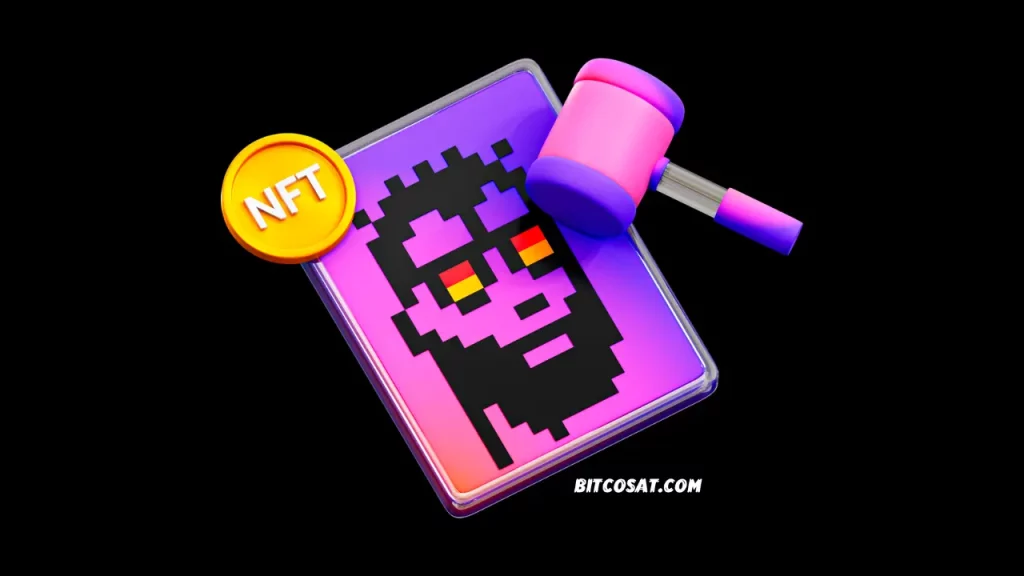
The platform hosts all NFT categories although some marketplaces that focus on a single category have emerged.
Users can purchase tokens for art, as well as purchase assets used in virtual worlds, trading cards for sports games, and purchase game items and domain names.
Currently, the most popular non-fungible art tokens are digital images, GIFs, or videos on the blockchain.
4. Low fees
The market features a simple charging model where the platform charges 2.5% on all transactions that occur on it.
Its market is offered for free, but this percentage is applied to all sales in addition to imposing a 10% fee on the original creator of the NFT.
Therefore, the market is characterized by charging lower fees than other platforms, in addition to the ease of creating an NFT on the platform.
It can be minted using an NFT minting tool from the market, and start creating a collection without technical knowledge of the blockchain network or the field of programming.
This service is also free, given that many competitors charge fees for creating NFTs.
5. Zero Gas Fee Program
The number of new users has increased and joined the crypto industry.
So the company took care of solving the problem of minting tokens, which was a cumbersome and difficult process in addition to the expensive gas fees, which ranged between 50 and 100 dollars.
The more the Ethereum network is used, the higher the cost of transactions.
So the market has simplified this process by adopting a zero gas fee program in 2021.
The pool manager allows creators to create tokens with no upfront gas cost and the token is not transferred on-chain until the first transfer or purchase is made.
6. Founding developer team
The founding team is not anonymous but has a good reputation.
Their files and CVs are on the LinkedIn platform, and this happened with the new team as well.
Plus, the company received a huge boost from accelerator Y Combinator, so all of these factors are making an amazing difference in the crypto industry.
Pros and cons of the OpenSea marketplace
OpenSea Marketplace Pros
– Anonymous purchases
The OpenSea platform promotes the principle of anonymous crypto.
The platform does not require creating an account, but rather simply connects the crypto wallet.
The user does not share his personal information when buying or selling NFT tokens.
The platform states that it may collect personal data to improve its services and collect the blockchain address used on the website.
However, when making transactions, this information must be hidden from other buyers on the platform.
– More than 200 payment options
The market sells digital items on the blockchain so transactions are mostly done with cryptocurrencies.
The market supports more than 200 payment options, and Ethereum is the most accepted method of payment.
The platform accepts payments in cryptocurrency and allows secondary sales in addition to payment through stablecoins, major currencies, or coins such as WBTC.
All payments on the platform including gas fees and transaction fees are made using Ether.
– An amazing number of collectibles
The market offers more than 20 million assets that a user may own at a time when competitors focus on a single asset.
The market provides different options for listing NFT tokens, as they can be sold through an auction or through a fixed price, such as the Artwork collection, which represents the most popular category at present.
Various collectibles and trading cards can be obtained, in addition to a variety of tokens, as the market hosts more than two hundred categories of digital assets.
The platform includes a table that displays a ranking of the best NFTs according to the market value of each, and this table is updated every hour.
– Active market community
The NFT market has boomed in the last year and the OpenSea market represents the largest part of this industry.
Therefore, it has an active community that has reached one million users, and the market value of OpenSea currently stands at $13.3 billion.
CryptoPunks game assets and Bored Ape Yacht Club tokens represent the highest volume.
In addition to the entry of NFT into many industries outside the crypto community, such as pop music, which has increased the number of new users supporting this leading industry.
– OpenSea Mobile application
The platform released its mobile app for Android and iOS in September 2021.
This application acts as a gallery and browser for artworks and for sharing lists, where you can view and manage the user’s NFT collection.
The application provides a search for NFTs but does not allow transactions at present like its competitor, Rarible Marketplace.
However, this is part of the company’s expanded plan, as the current goal is to increase the spread of NFTs among users.
OpenSea Marketplace Cons
It is necessary to monitor a complete picture of the marketplace, so let us highlight some of the negatives:
– Does not support fiat currencies
OpenSea Market acquired DermaLabs in 2022, allowing the $13 billion cryptocurrency company to expand its technical capabilities.
Derma, a leading company in decentralized finance, wanted to create an easy interface for the user to lend or exchange tokens.
This may pave the way to a different crypto world devoid of securities by depositing these securities using debit cards and exchanging tokens through the Uniswap v3 platform.
– Centrality
The market represents a central exchange for non-fungible tokens similar to the Coinbase exchange.
The platform hosts NFT projects with all their data and content in a central way.
There is currently no NFT wallet, and it is not permissible to display the user’s token information outside the platforms where the code is sold.
OpenSea marketplace is working to solve the centralization problem soon.
– Administration
A senior employee from the company, Nate Chastain, resigned in September 2021 as a result of being accused of insider trading and bidding on the tokens that appear on the site’s home page.
So the company promised to take strict action against team members who use confidential information for NFT token purchases.
– Safety
NFT tokens can be stolen as a result of bugs that attackers can exploit in the market.
To be sold for much less than its market value and then resold for huge profits.
Some hackers have already made more than $1 million, so some industry experts believe that OpenSea’s design of a unique user interface makes it overlook the security elements within the platform.
– Supported wallets

Here is the list of wallets compatible with the OpenSea Marketplace:
- MetaMask
- Coinbase Wallet
- Trust Wallet
- Portis
- Fortmatic/Magic
- Venly
- Authereum
- Bitski
- Dapper
- Kaikas
- OperaTouch
- Torus
- WalletConnect
- WalletLink
– NFT tokens supported by OpenSea Marketplace
There are two types of tokens that the market supports: ERC-721 tokens registered on the Ethereum and Polygon networks and KIP17 tokens registered on the Klaytn network are Type 1 tokens and are non-fungible.
The second type is semi-fungible, which are ERC-1155 tokens registered on Ethereum and Polygon, and KIP37 tokens on the Klaytn network.
As for the categories; The marketplace has a large variety of NFTs, which sets it apart from many competing marketplaces that typically focus on one type, such as the MagicEden Marketplace, which focuses on Solana only.
Which helped the OpenSea platform sell the largest number of NFTs.
NFTs include different types of art, music, domain names, virtual world tokens, trading cards, digital collectibles, tokens, as well as sports trading cards.
How to start using OpenSea?

Buying and selling via the OpenSea Marketplace is easy and provides an enjoyable crypto experience.
Here are the steps to follow when getting started on OpenSea:
- Buy Ethereum
Make sure you have enough Ethereum funds to purchase an NFT.
- Create a cryptocurrency wallet
The marketplace supports many web3 wallets such as the MetaMask wallet.
- Send Ethereum to Wallet
Transfer Ethereum to the wallet.
- Connect wallet
Through your profile, connect your wallet to the platform.
- Log in to the wallet
After logging in, go to your profile page and edit before making your purchase.
- Visit the marketplace
Select the NFT category you want and filter the results to your liking.
- Buy NFTs
Click Buy Now after selecting the NFT and the price and fees will be displayed. Then click Checkout to approve the transaction in your wallet.
- Confirmation
You will be asked to confirm or reject the transaction. Click Confirm and the NFT will be in your wallet minutes later.
The OpenSea Marketplace is a good place to start
The OpenSea marketplace is considered the most famous market and hosts the most famous NFT tokens.
It also simplifies trading for these tokens and thus enables new people who want to trade cryptocurrencies to join the marketplace community.
However, there are some drawbacks, such as the system’s decentralization or lack of support for fiat currencies.
The marketplace is a good place to start in the NFT space, which is constantly growing, and thus OpenSea will be one of the most prominent beneficiaries of this growth.
